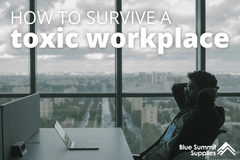Body language is a type of nonverbal communication that includes the vast number of ways we communicate with our bodies and facial expressions. Poor body language—hands in pockets, poor posture, or fidgeting—can undermine what we’re trying to communicate with our words. Negative or ineffective body language can make us come across as nervous, aggressive, or impatient, and it can make those around us feel incredibly uncomfortable.
Utilizing body language effectively can build trust with team members, illustrate a point, and put people at ease. This post will outline the types of negative body language you should avoid and how you can improve your body language in the workplace.

Nervous Body Language in the Workplace
It’s natural to get nervous sometimes, especially during public speaking or when being addressed by an intimidating boss. Though, just because it’s natural doesn’t mean it’s the image we want to project to those around us. Despite feeling nervous, we can still control our body language and nonverbal cues in order to display more confidence.
Nervous body language to avoid:
- Hands in pockets
- Fidgeting hands
- Fidgeting with objects
- Pacing
- Rocking/Swaying
- Freezing
- Avoiding eye contact
- Looking from side to side
- Blushing
- Ear grabbing
- Lip biting
- Nail biting
- Leg shaking
-
Shaking/quivering hands

Aggressive Body Language in the Workplace
Aggressive body language can intimidate those around you, and it has no place in a work environment. This type of nonverbal communication, whether intentional or not, erodes trust and creates a toxic workplace.
Aggressive body language to avoid:
- Scowling
- Glaring
- Extreme hand gestures
- Flipping the bird
- Intimidating posture
- Red face
- Exaggerated stretching
- Clenched fists
- Hitting a table
- Knuckle cracking
-
Clenched jaw

Impatient Body Language in the Workplace
Impatient body language will make the people around you uncomfortable, whether you intend it to or not. Simple gestures, such as looking at a smartwatch during a meeting, can signal that you don’t want to be there or don’t have time for your colleagues. Pay attention to your body language to ensure you don’t make those around you feel like you have somewhere better to be. It’s disrespectful, and it will erode mutual rapport with your team members.
Impatient body language to avoid:
- Eye rolling
- Avoiding eye contact
- Sighing
- Slouching
- Looking at the clock
- Looking at a watch
- Looking at the ceiling
- Checking your phone
- Moving towards the exit
- Frowning
- Leg shaking
- Placing your head in your hand

Body Language: Hands in Pockets
Putting your hands in your pockets indicates insecurity and meekness. Sometimes, of course, this is just an attempt to get more comfortable, but trying to get more comfortable is also something one would do if they were feeling uncomfortable or insecure. Concealing your hands unconsciously signals to someone that you’re hiding something.
A popular theory behind the origin of handshaking is that it was meant to show the other person you weren’t carrying a weapon. While it’s unlikely your coworkers are carrying weapons, being unable to see another person’s hands makes us naturally suspicious of what’s in them.
When you’re communicating with someone, make sure to keep your hands out of your pockets and generally visible. Utilize simple hand gestures to support what you are trying to communicate and to keep colleagues at ease.

Body Language: Hand Gestures
Depending on how they are used, hand gestures can aid or hinder communication. Simple hand gestures and signs of enthusiasm can add to your point and make people feel more engaged in what you are saying.
If hand gestures become too erratic or exaggerated, they can begin to distract from your point. They can also come across as intimidating if other aspects of your body language are aggressive, such as if you are frowning or if the tone of your voice is angry, deep, or flat.

Body Language: Posture
It’s understandable to grow tired after a long day at work, which can make us hunch or slouch our shoulders. Unfortunately, this communicates apathy and a lack of confidence. Bad posture can make you seem timid, shy, and unapproachable.
Bad posture is also bad for both our own physical and mental health. Slouching not only communicates sleepiness and sluggishness to others, but it also makes us feel that way. And physically, prolonged bad posture causes stiffness, neck and shoulder strain, back pain, joint damage, and arthritis.
If you notice yourself slouching at work or if you’re feeling sluggish, try standing or sitting up straight, or take a walk outside or around the office. If you’re at your desk, slide your bum forward in your seat to help you straighten out your back.

Body Language: Signals of Aggression
Even if you become angry at work, it’s important to keep your cool. And although you may not be expressing your anger or aggression out loud, it’s often quite clear to those around you through other nonverbal cues.
There are a number of different ways our bodies display aggression, and sometimes trying to display confidence can be misinterpreted as aggression. It’s a fine line to walk, and what matters most is how other people feel about your body language—not your intentions.
It’s important to project confidence, but watch that you don’t do so with an intimidating posture, clenching your fists, using extreme hand gestures, or any of the aggressive body language outlined above.
How to Improve Workplace Body Language

Analyze Yourself and Ask for Feedback
Nonverbal communication takes practice, and it’s something you can continually work on. Practice speaking and communicating in a mirror. Use a full body mirror, if you have one available, so that you can assess your hand gestures, posture, and stance. Does how you feel match what you see in the mirror? If you feel confident, do you look it? Do you come across as timid or aggressive?
It’s important to involve other people in this process too since you won’t be able to fully recognize how your body language comes across to others. Pay attention to how other people react to you. Does it seem like your intentions are regularly understood, or do you frequently run into misunderstandings in the workplace?
Ask your colleagues, managers, and mentors for feedback on your nonverbal communication. One-on-one meetings are an ideal opportunity to request this kind of insight. Be open to receiving the feedback, and be prepared to make changes to your body language once you learn how it is being received.

Utilize Eye Contact
Making and maintaining eye contact is one of the most important things you can do when communicating with someone. It lets the person speaking to you know that you’re actively listening and paying attention to what they have to say. When it’s you that’s speaking, maintaining eye contact with the person you’re speaking to communicates confidence, assertiveness, and a belief in what you’re saying.
Sustained eye contact with someone also triggers our brains to release oxytocin. Oxytocin is a social bonding hormone that decreases stress and creates a sense of wellbeing and connection. So although it can be intimidating to meet someone’s eyes and maintain eye contact, doing so will actually reduce that anxiety.
When trying to maintain eye contact, watch out for other types of nonverbal communication. Sustaining eye contact can be intimidating if you are glaring or scowling at the same time. Practice in the mirror to make sure your eye contact doesn’t mistakenly come across as intimidating.

Mirroring Body Language
This body language technique involves matching the body language of the person you’re speaking with in order to build rapport or increase attraction. People are naturally more comfortable with people they feel they’re alike to, so mimicking the movements, posture, or general attitude of the person you’re communicating with will strengthen the bond you have with your coworkers.
Mirroring someone’s body language also happens unconsciously when we’re attracted to or admire the person. Have you ever found yourself mimicking an older sibling or someone you thought was cool?

Practice Body Language in Public Speaking
Body language becomes hugely apparent during public speaking. Whenever you give a speech, deliver a presentation, or run a meeting, people are watching your body language closely. So much so that your body language may begin to distract from your words.
Mastering your body language when speaking in front of a crowd takes continual practice. It’s likely that you don’t even know which uncomfortable or distracting body language habits you've built until you’re told about them or see them for yourself.
Always ask other people for feedback—and make sure they know you mean it. Tell your friends, family, mentors, and whomever else you trust to be brutally honest. Hearing from other people will help you recognize what you need to improve upon. It could be that you speak too quickly, pace around, exhibit shy posture, avoid eye contact, or fidget with your presentation notes. Whatever they may be, it’s important to identify your bad habits so that you can focus on eliminating them with ongoing practice.
More From Blue Summit Supplies
💡 Transparent Communication in the Workplace
💡 Virtual Meeting Etiquette Tips and Online Meeting Rules
We’re dedicated to helping businesses improve communication, productivity, and wellness. Follow our office supplies blog for the latest trends, office strategies, product comparisons, and more.
If you have any questions or want to talk to our team, send us an email or connect with us on Twitter, Facebook, or Instagram.
 For more informative articles about office supplies, subscribe to our email newsletter!
For more informative articles about office supplies, subscribe to our email newsletter!
Never fear, you won't begin receiving daily sales emails that belong in a spam folder. Instead, we promise a fun weekly roundup of our latest blog posts and great finds from across the web. And if you lose interest, it's always easy to unsubscribe with a single click.









